Why is a marketing budget so crucial?
The bottom line, or your return on investment (ROI). By allocating resources wisely and measuring the impact of your marketing efforts, you ensure every dollar spent contributes to the growth of your business.
Click here to download a free marketing budget template.
But beyond the financials, your marketing budget helps you prioritize marketing initiatives and identify areas for improvement.
In this article, I’ll guide you through the steps to create a comprehensive and usable budget. I’ll also share how to use the attached free marketing budget template to make the budget allocation process easier.
So, let's dive in and make every marketing dollar count!
What Does a Marketing Budget Cover?
The marketing budget covers how you intend to allocate your financial resources between marketing projects and channels over some time, typically a quarter or a year.
How much are you going to spend on each of your marketing activities? Why's your strategy going in this direction? The budget helps you answer these questions by considering marketing ROI.
This allows you to:
- Achieve your marketing goals
- Use your resources strategically and efficiently
- Avoid overspending
- Get stakeholder and management buy-in
Specifically, the marketing budget plan covers all your marketing-related costs — from marketing software and ad spending to content creation, new hires, and contractors.
Creating a marketing budget involves mapping all your marketing initiatives and their budget allocation in line with the expected ROI. This is one of the trickiest parts of building a budget.
There’s no magic marketing formula to help you split your budget. It’s more about making strategic decisions based on past performance, current resources, and industry trends. And this is what I’ll aim to help you figure out.
How Much Should Your Marketing Budget Be?
You can determine your marketing budget based on industry benchmarks, historical performance, marketing goals, and business growth stages.
In general, many companies calculate their marketing budget as a percentage of revenue. The table below shows the percentage of revenue companies in different industries spend on their marketing budget.
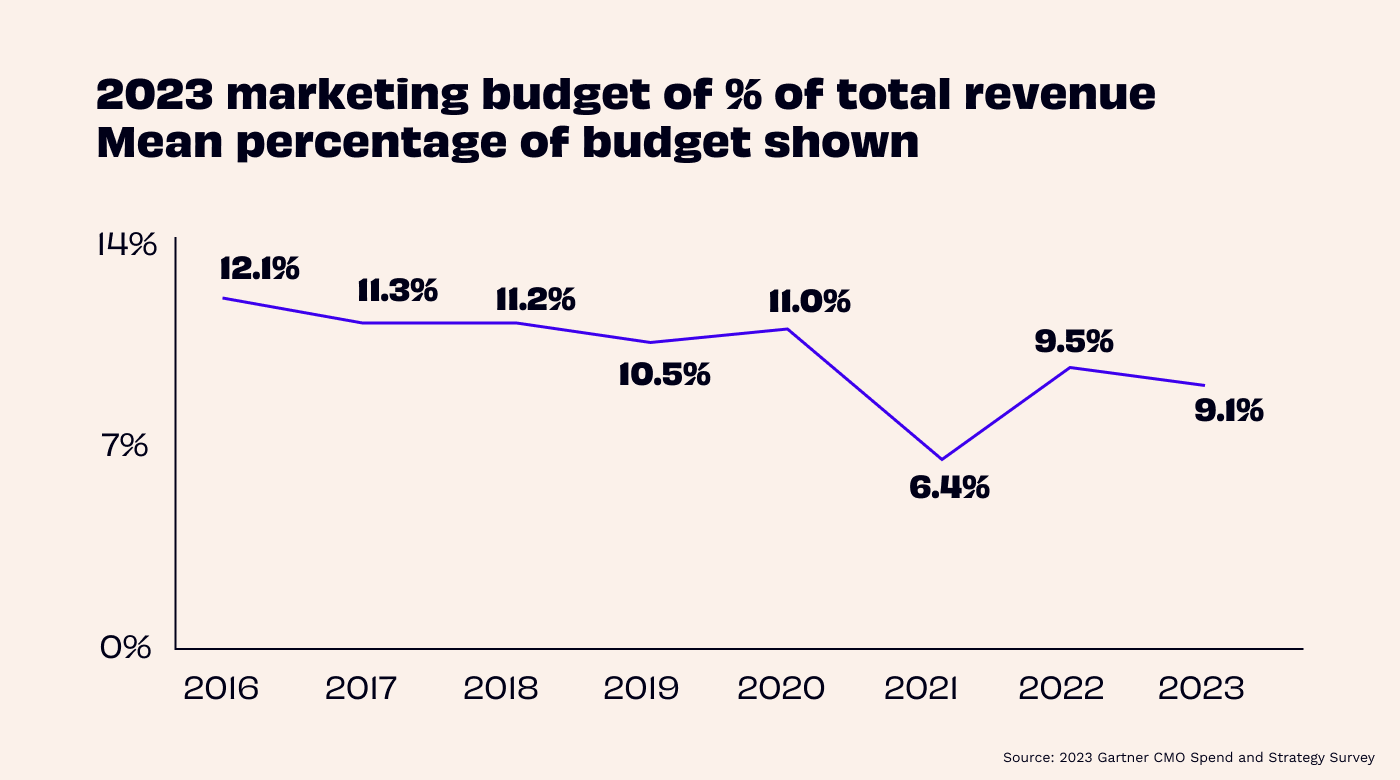
Recent stats show that companies in 2023 are allocating 9.1% of total revenue to marketing activities on average (Gartner's CMO's Guide to Crafting a Marketing Budget). It’s worth noting that this is a decrease from last year — companies in 2022 were allocating 9.5% of their revenue to the marketing budget. However, since 2016, the percentage has kept going down.
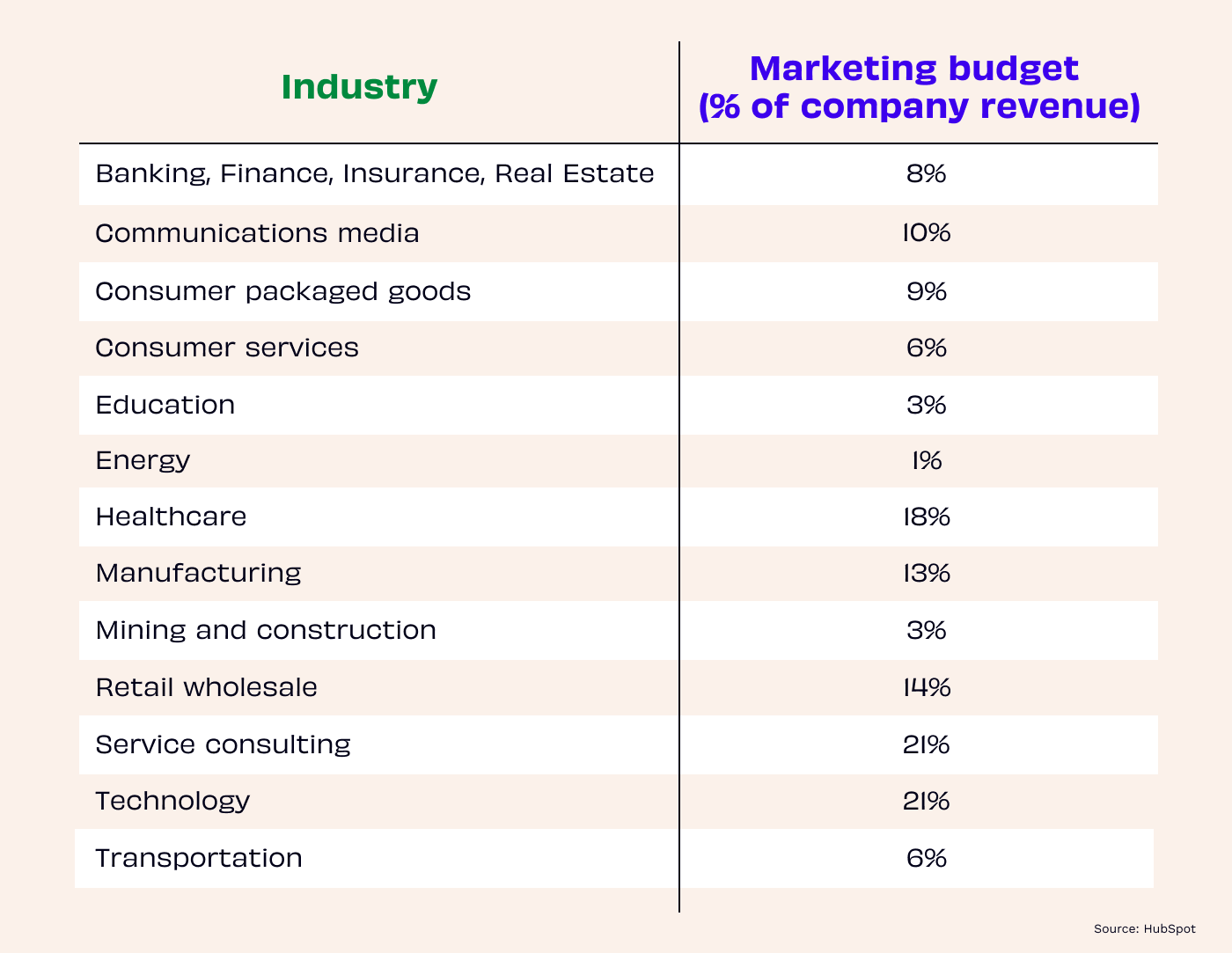
Another survey also shows that 42.3% of companies (The CMO Survey, 2022) are decreasing marketing spending. This might seem like an invitation to lower your budget in line with your competitors. However, before making such decisions, consider balancing your short-term gains with your long-term goals.
And if you are experiencing budget cuts, know that 75% of CMOs (Gartner's CMO's Guide to Crafting a Marketing Budget) face the challenge of doing more with less. This requires looking at the budget with a more strategic and creative eye.
How to Create a Marketing Budget
Alright, now let’s get into the practical stuff.
1. Review Your Past Performance
Start by reviewing your past marketing performance in relation to the assigned budget.
Lay out all your marketing costs.
Look at how much you spent the previous year on your marketing efforts. Was it more than you had planned? Less? Why?
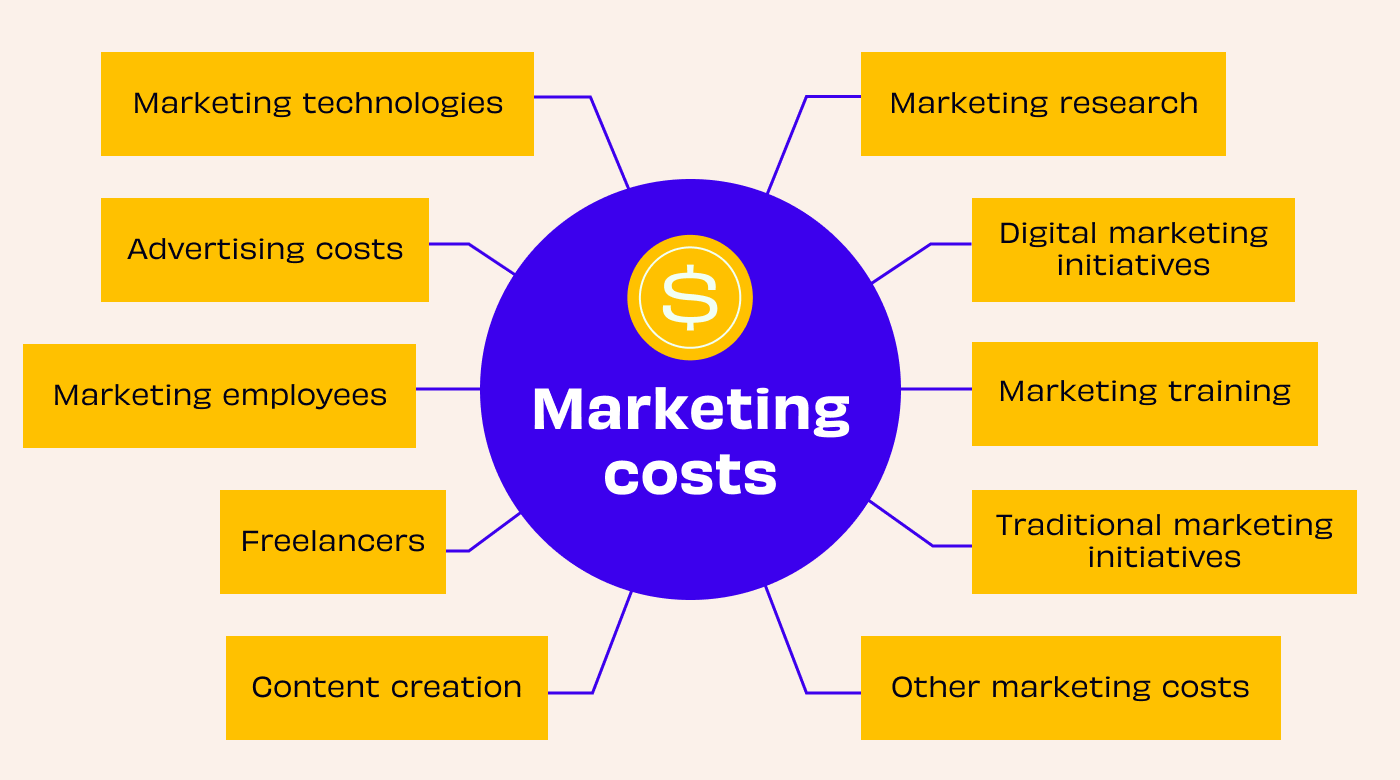
Check all your common marketing cost categories. It helps to put a concrete value next to each category. Some common spending categories are:
- Marketing technologies, from your keyword research tool to your video editing software
- Advertising costs, including all digital advertising activities (i.e., Meta advertising and Google Ads) and traditional advertising campaigns
- Employee salaries and contractors, plus any freelancer help you might need
- Marketing training, such as team training, courses, and conferences
Once you group all your marketing expenses into different categories, write how much you’ve spent on each category in total.
Now that you know how much you’ve spent on different areas of marketing, you can evaluate the effectiveness of your spending.
- First, review the projected vs. the actual spending. Did you go over or under budget? Then, look at key metrics like ROI, conversion rates, customer acquisition costs (CACs), and revenue. How well did you hit the previous period’s objectives?
2. The numbers don’t tell you the whole story. Dig a bit deeper beyond numbers to look at customer journey analytics. Ask the following questions:
- Which parts of the journey are you serving well? How are you achieving that?
- Which are your most successful initiatives? Identify the initiatives that are performing well alongside their ROI.
- Which journey areas need improvement or more attention?
- Which parts of the customer journey bring the highest return?
These questions will help you evaluate your budget effectiveness and performance from a more customer-centric perspective.
So, let’s say the influencer marketing campaigns you experimented with for the first time last quarter were highly successful and brought you a ton of awareness regarding website visitors and social media followers.
How does this increased awareness translate into actual revenue? You might discover that while influencer campaigns are helping you excel in the awareness stage of the buyer journey, which is not translating very well into sales.
This might mean that you might collaborate with the wrong influencers or might need to change your campaign messaging or targeting. On the contrary, it might show you that the increased awareness also translates into better sales. So you know to continue investing in that marketing channel and even improve your allocation this quarter.
The conclusions you draw from this step will help you move forward with the next one.
2. Establish Your Marketing Goals and Objectives
Everything you do should align with your business and marketing objectives. Is the business heading in a new direction or entering a new market? Are you launching a new product or going through a rebrand?
In which areas of the customer journey do you need to focus more to achieve your goals? Do you need to attract more leads, increase your conversion rate, or lower your CAC?
These are all factors you should consider when setting your budget. If you’ve built your marketing strategy, you might have already established your goals and objectives for the next period. So, simply revisit those.
One thing I’d recommend you do in this step is to set SMART goals. This means setting Specific, Measurable, Actionable, Relevant, and Time-bound goals. These goals make it easier to calculate your budget properly.
An example of a SMART goal could be to increase social media engagement by 20% in the next three months. With a SMART goal, your team can develop a well-defined plan to achieve it. This allows you to allocate the needed budget better.
3. Allocate Your Budget
Taking all the above into consideration, in this step, you’ll decide on your budget allocation.
You can allocate your budget in a few ways, such as across the customer journey, marketing channels, initiatives, or other common categories.
In this stage, you’ll need to make a few decisions, which I’ll walk you through below.
Across the customer journey
One way to split your budget is to look at it from the customer's viewpoint. Many companies decide to go this route. As we can see from the graphic below, companies spend around a quarter of the budget on each journey stage, with the awareness stage taking the lead.
This shows that CMOs allocate slightly more to awareness-stage initiatives — and slightly less to loyalty and advocacy programs. Also, in the middle of the funnel, the consideration and conversion stages take the biggest budget chunk.
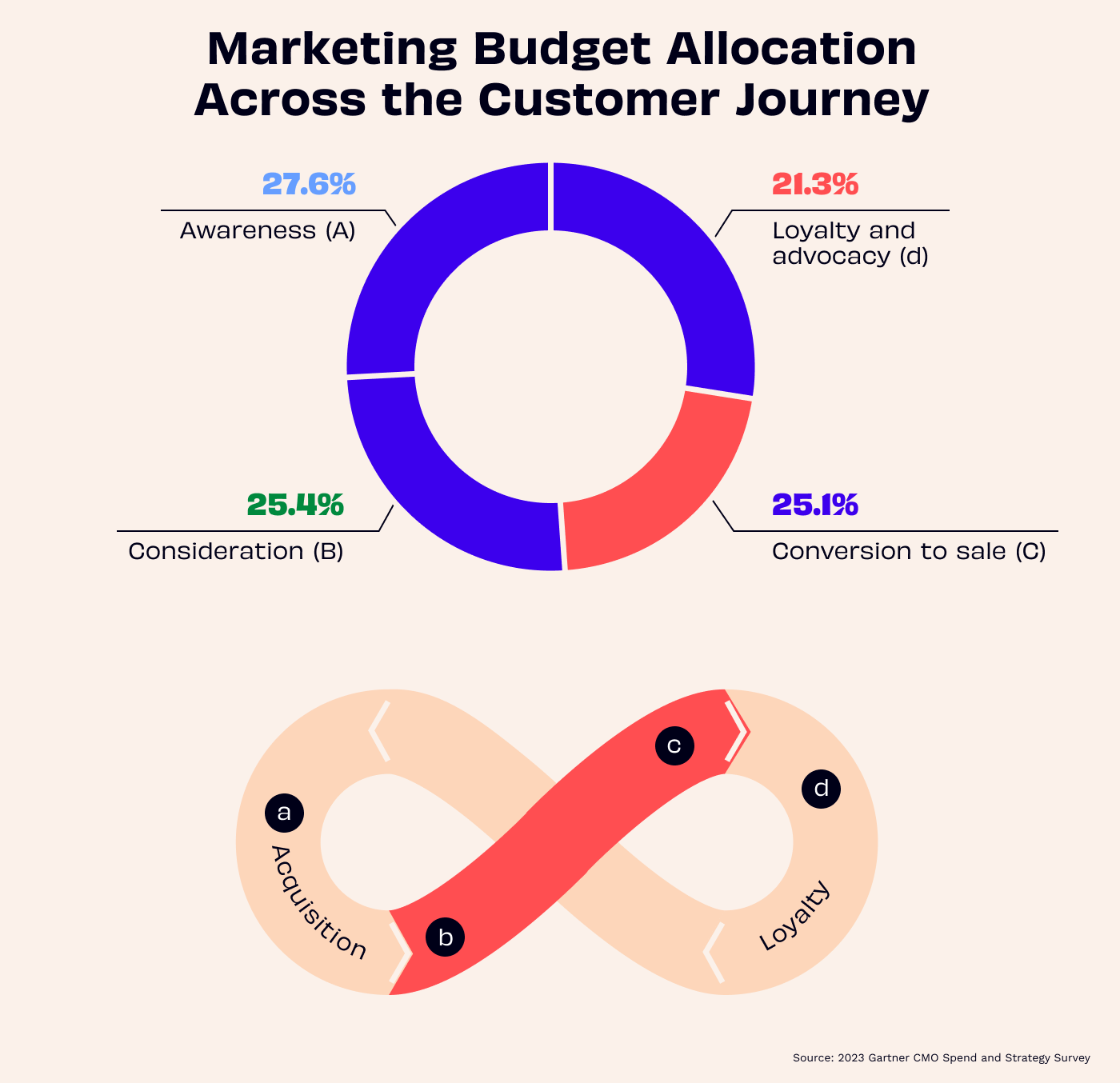
Look at your own customer journey insights. Which stages are bringing the highest ROI, and which ones are underperforming? Are you introducing new initiatives or marketing campaigns in any of them? For instance, if you’re planning to invest in influencer collaborations in the next quarter to increase your brand awareness (SMART goal), it might make sense to allocate a bit more of the budget in that area.
Marketing channels, platforms, and campaigns
Another way to look at budget allocation is through your marketing channels, platforms, and campaigns. Consult your marketing planning software on this. Look at your marketing categories and put an estimated cost next to each activity.
The figure below shows how CMOs allocate their digital marketing budget this way.
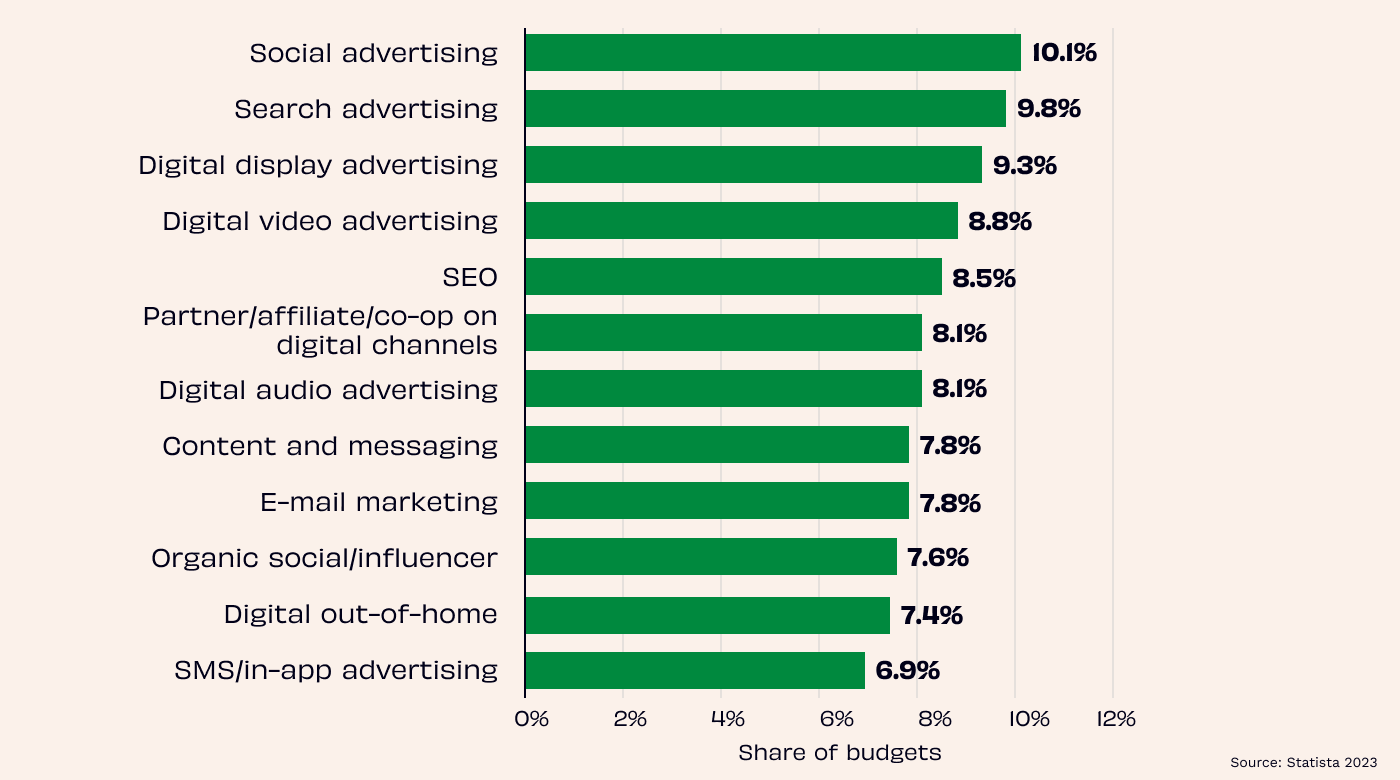
Different forms of online advertising take the top spots on the chart, with the highest share of the budget.
Also, it’s worth taking a closer look at social media channels. And ask the same question we’ve been asking throughout this process: Which ones have the highest marketing ROI?
Regarding social channels, Instagram and Facebook are the top two platforms with the highest ROI (HubSpot's 2023 Social Media trend Report).
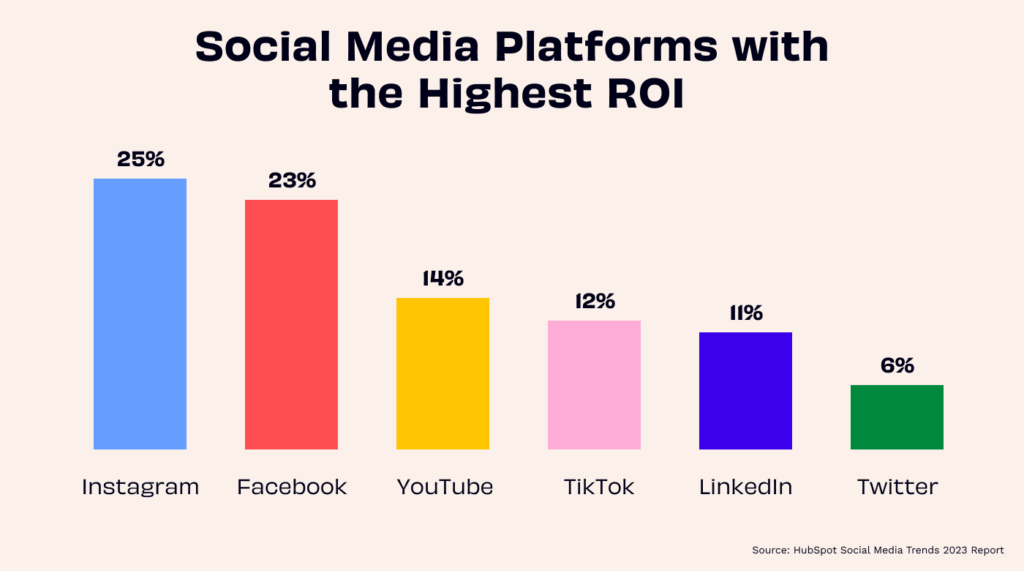
Another way to look at it is through the famous 70-20-10 rule. The rule suggests dividing the marketing budget into three main categories:
- 70% on core marketing activities: well-established strategies and channels that show positive results, e.g., advertising on established channels, running email campaigns, and investing in search
- 20% on innovation and growth: trying new marketing initiatives and exploring innovative approaches; e.g., experimenting with emerging social media platforms, piloting new advertising formats or creative concepts
- 10% on experimentation: discover new opportunities by testing out new ideas
The percentages are, of course, a guideline. They can look different depending on your business. If your business is going through a rebranding and innovating phase, you can focus a more significant share of your budget on the innovation and growth bracket.
Tip: Don’t ignore your offline marketing efforts when calculating your budget. Consider the budget you’ll need for activities like trade shows and events.
Talent
Hiring and retaining the right people should be one of the key priorities of every marketing department. Labor costs account for 24.6% of the marketing budget in companies (Gartner's CMO's Guide to Crafting a Marketing Budget). There's fierce competition out there to hire and retain talent.
Based on the laid-out marketing initiatives, see if you’ll need to hire new in-house talent or collaborate with freelancers or agencies. Don’t forget also to consider the cost of training.
Technology
Marketing technology will probably take up a considerable part of your budget. Big organizations can expect to spend around $5,000 per month (WebFX's Martech Pricing in 2024) on marketing tools and platforms.
However, 75% of CMOs (Gartner's State of Marketing Budget and Strategy in 2023) are facing pressure to cut their MarTech spend. If this also applies to you, then it’s an excellent opportunity to look at MarTech stack examples. You’ll want to build a stack that's effective and efficient. Sometimes, you can spot tools with overlapping functionalities.
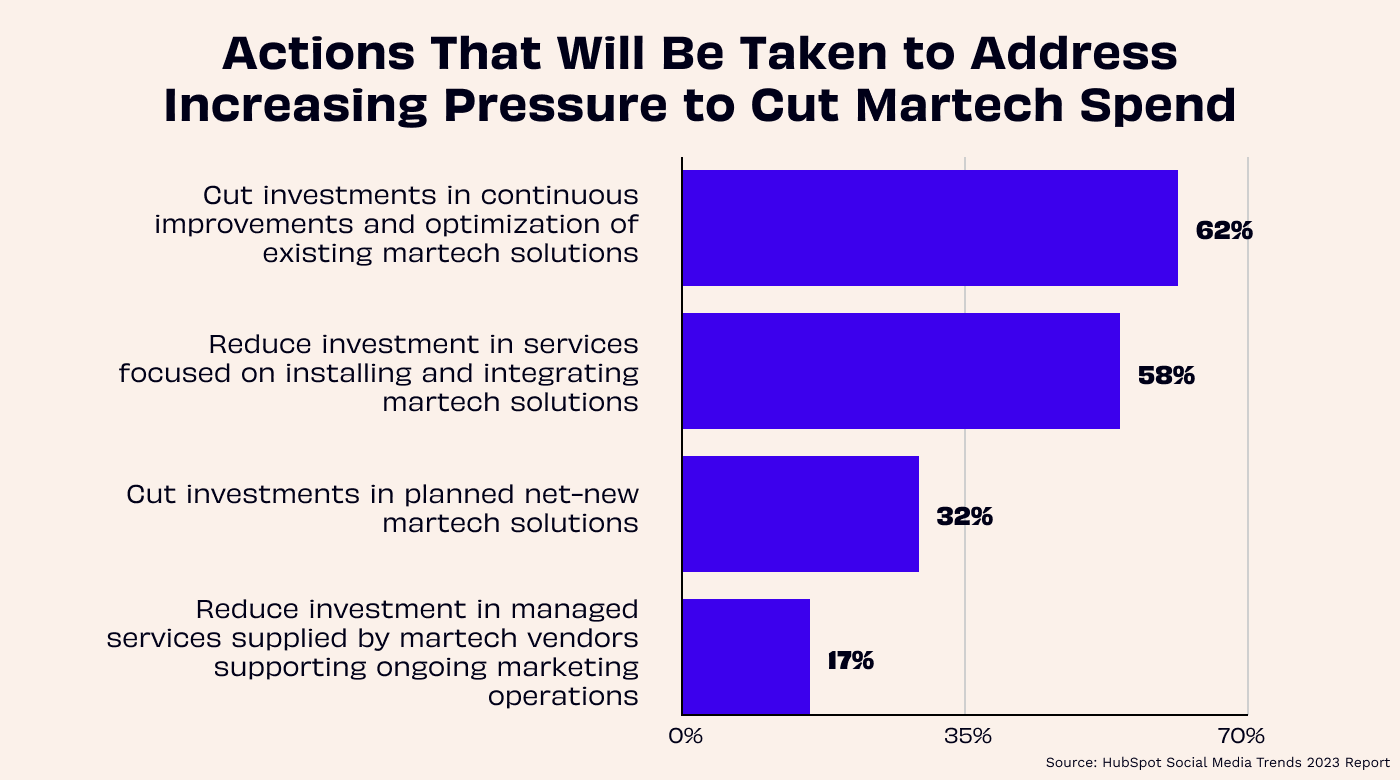
Other costs
This category accounts for additional expenses that arise throughout marketing activities. It includes incidental costs, such as event sponsorships, market research, promotional materials, training and development, or unexpected expenditures that don't fit neatly into the predefined categories.
I suggest you keep a buffer for other marketing costs. This will allow you to be flexible and responsive and cater to unforeseen opportunities and challenges. How much the buffer will be depends on several factors. You will need to keep a bigger buffer if you’re operating in a rapidly changing industry or if you are more open to experimentation and risk-taking.
It’s also good to look at how much you’ve allocated to this category in previous years. Did the actual cost align with the projected cost? Adjust accordingly.
5. Implement Tracking Mechanisms
You set up your SMART marketing objectives in step two. Now, you need to ensure you bake in a marketing measurement process into your marketing activities.
You can rely on analytics tools like Google Analytics, social media insights, or email marketing platforms to analyze the performance of your marketing campaigns. Use tracking links (UTM parameters) for marketing channels to monitor traffic sources and campaign effectiveness. These links can be easily generated using tools like Google's Campaign URL Builder.
For online campaigns, set up conversion tracking on your website to measure actions taken by visitors, such as form submissions, purchases, or sign-ups. If you run offline campaigns or have brick-and-mortar stores, consider assigning unique promo codes to different marketing initiatives. This way, you can track the number of redemptions from each campaign.
Keep track of your real spending vs. your projected spend. Use analytics tools to measure your performance and translate everything into numbers — ROI and your other KPIs. Keep track of historical data to identify trends, seasonality, or patterns in your marketing performance. This can help you make more informed decisions in the future.
Establish a routine for reviewing your marketing data and KPIs regularly. Regular budget check-ups will help keep you on track and focused on your goals. Moreover, this way, you can also adjust the budget when needed.
Common Pitfalls to Avoid When Creating Your Marketing Budget
When creating your marketing budget, it's essential to be mindful of common pitfalls that can hinder the success of your marketing efforts. Here are some pitfalls to avoid:
- Insufficient research and planning: Skipping the research phase can lead to inaccurate budget allocations and ineffective marketing strategies. Before finalizing your budget, understand your target audience, industry trends, and competitors.
- Overestimating returns: Avoid setting unrealistic expectations for the returns on your marketing investments. Be conservative and realistic when projecting outcomes to avoid disappointment.
- Underestimating costs: Be thorough in estimating the costs of your marketing activities. Account for all expenses, including creative production, advertising spend, tools, and personnel.
- Ignoring past performance data: Failing to analyze past marketing performance can lead to repeating ineffective strategies and wasting resources. Review historical data to identify what worked and what didn't.
- Focusing on short-term goals only: While short-term goals are important, don't neglect long-term marketing strategies that build brand loyalty and sustainable growth.
- Failure to track and measure results: Not implementing tracking mechanisms can make it difficult to gauge the effectiveness of your marketing budget.
- Lack of flexibility: Market conditions and consumer behaviors can change, so be prepared to adjust your marketing budget and strategies accordingly.
How to Use a Marketing Budget Template
A marketing budget template is a pre-designed document or spreadsheet that helps you plan, organize, and track your marketing expenses.
It serves as a structured framework to outline the marketing activities and associated costs for a specific period, typically a quarter or year.
With a template, you can maintain a consistent format and structure across different budgeting periods, making comparing and analyzing historical data easier. Yet, it allows you enough flexibility:
- To adapt and adjust as needed
- To modify your marketing budget in response to changing market conditions or new opportunities.
As you execute marketing campaigns, you can regularly update the budgeting template with actual expenses to compare against the planned budget.
Using a pre-designed template saves you time and effort; you don't have to create a budget from scratch. Using a pre-designed template allows you to skip the tedious process of formatting and structuring the budget.
The template provides a ready-made framework, allowing you to concentrate on setting marketing objectives, analyzing data, and making strategic decisions.
You can see the template as a planning tool that helps you think strategically regarding your budget. Remember that creating your budget is a process; it’s not simply about filling in the blanks.
There are different types of marketing budget templates out there.
- You can use master overview budget templates to have a high-level view of your budget or a more specific one.
- An activity-specific marketing budget template allows you to go into more detail about the costs of activities like a new product launch or website redesign.
- A channel-specific template breaks down the cost information of your different marketing channels.
You can find various marketing budget templates online or create one from scratch using spreadsheet software like Microsoft Excel or Google Sheets. Also, I've added a link to the free and customizable marketing budget template below.
Free Marketing Budget Template (Excel)
As promised, here’s a free marketing budget template you can copy, edit, and download. Use this template to organize your marketing budget data so it becomes accessible as a snapshot.
Access Your Free Marketing Budget Template Here
The template is comprised of two parts. In the first part, you can fill in your 70-20-10 budget split. Even if you don’t typically use this type of split, it’s a good exercise to force you into thinking about how innovative you’re being.
So, let’s say you have a total marketing budget of $250,000 to allocate. According to the 70-20-10 split, 70% of your budget, which is $175,000, goes to your core marketing activities, $50,000 into innovation & growth activities, and $25,000 into marketing experimentations.
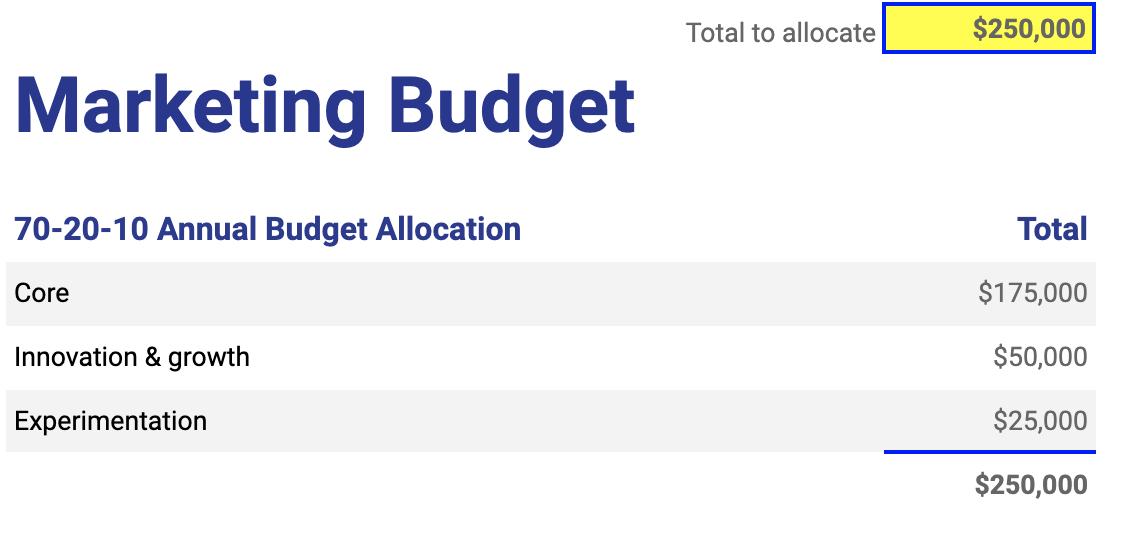
If you don’t have this split already figured out, feel free to fill in this part last. Filling in the next part will help you with this one.
The 70-20-10 split is not set in stone. If you’re launching a new innovative product, it might make sense to put more money into innovation, growth, and experimentation efforts. So, in this case, it might look more like 50-30-20.
The second part of the template has a breakdown of common marketing cost categories. The categories in the template are marketing technologies, marketing research, training costs, advertising costs, and the budget that’ll go into salaries and paying freelancers. These are the big budget buckets; you can and should change the categories to fit your budget split.
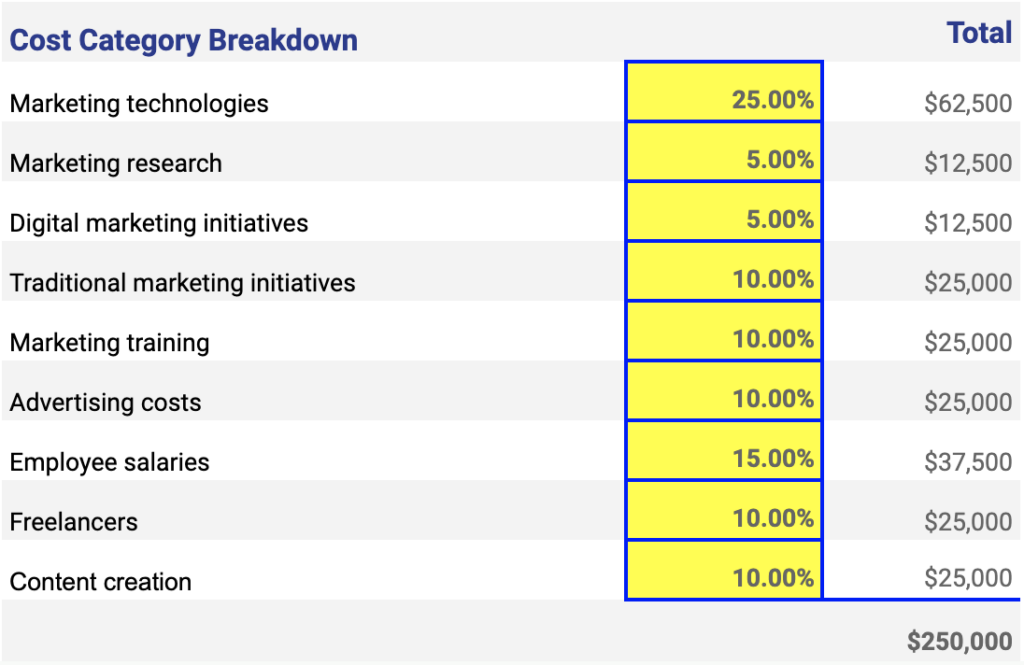
The template is fully customizable. But let’s say you have a total marketing budget of $250,000. Here, you can track what percentage of your total budget you are allocating to each category and the actual money sum.
Use the template to organize your marketing budget. Customize it as needed. Above all, the template can also serve as a tool to help you with the budget allocation process.
At the end of the year, you can use the template to compare your allocated spend with the actual budget spend.
You can also use it to compare each year’s budgets.
Put Your Marketing Budget Into Practice
Now, it's time to put your newfound knowledge into action.
Leverage the power of the marketing budget templates provided in this article. These templates offer a convenient and structured approach to organizing your expenses, tracking your activities, and ensuring efficient allocation of resources. Customize them to align with your specific business goals and industry needs.
And remember, a well-crafted marketing budget isn't a static document but a dynamic tool that requires continuous monitoring and adaptation. As you execute your budget, maintain agility and flexibility. Regularly evaluate the performance of your marketing initiatives, measure their impact, and make data-driven adjustments as needed.
And if you want more insights like this, then go ahead and sign up for our newsletter for marketing leaders like yourself right away.


